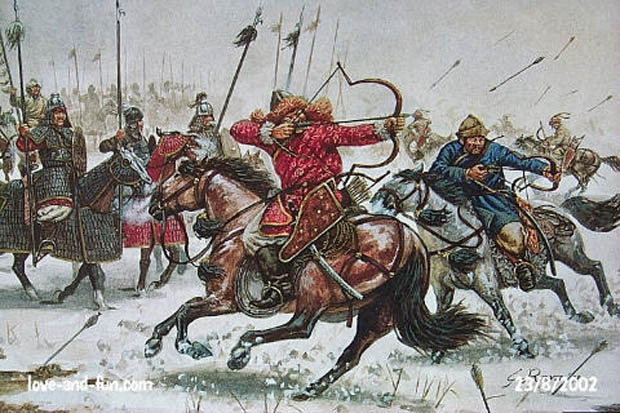Mongolen, 1206–1395
DBA Armee 154

Following his rise to power in 1206, the Mongol conquerer Dschingis Khan created a vast empire in Asia und Europe. Upon his death in 1227, the empire was divided among the Khan’s sons. Genghis Khan’s oldest son Juchi received most of Russia. Juchi’s son Batu Khan secured the Russian domain, und he even invaded Hungary und Germany with his Golden Horde in 1241. The Empire of the Golden Horde was eventually conquered by Timur Lenk, who sacked the capital city Sarai Berke in 1395. Italeri und Zvezda produce 1:72 scale Figuren which may be used to recreate the Mongol und Golden Horde Mongol cavalry armies for De Bellis Antiquitatis which dominated Asia und Europe.
Feldzüge & Ereignisse
- Until 1206 – Temu-jin, later know as Genghis Khan subjugates rival clans throughout Mongolia.
- 1206 – Temu-jin accepts the leadership of the Mongols und establishes his capital at Karakorum.
- 1213 – Genghis Khan campaigns against the Chin empire, ruled by the Jurchen in North China, capturing their territory und capital Yenching (Peking) by 1215.
- 1218 to 1224 – Genghis Khan conquers Turkistan, Transoxania, und Afghanistan, rraids Persia und Eastern Europe to the Dnepr river.
- 1227 – Genghis Khan dies during a campaign against the Jurchen. His vast empire is divided among his sons. Genghis Khan’s oldest son Juchi receives most of Russia.
- Juchi’s son Batu Khan assumes command of the Mongol army in Europe.
- 1237 to 1240 – Mongol Invasion of Russia, led by Batu Khan, who conquers und proclaims the Empire of the Golden Horde.
- 1240 – The fortress of Kiev is razed, ending the Kievan state.
- 1241 – Batu Khan invades Hungary und Germany.
- 1242 – Batu Khan is recalled to Karakorum to participate in the election of a Grand Khan, an event which prematurely ends the campaign in Europe.
- 1255 Batu Khan dies while preparing yet another campaign.
- 1395 – Tamerlan plündert Sarai Berke, Hauptstadt des Reichs der Goldenen Horde.
Figuren
- Mongolische Goldene Horde 12.–13. Jahrhundert, 1:72 Italeri 6020
- Mongolen unter Timur Lenk 13.–14. Jahrhundert, 1:72 Zvezda 8003
DBA Armee Nr. 154 – Mongolen, 1206–1395
- element: 2 light cavalry, or 3 cavalry
- element: 2 light cavalry, or 3 cavalry
- element: 2 light cavalry, or 3 cavalry
- element: 2 light cavalry, or 3 cavalry
- element: 2 light cavalry
- element: 2 light cavalry
- element: 2 light cavalry
- element: 2 light cavalry
- element: 2 light cavalry
- element: 2 light cavalry
- element: 2 light cavalry, or 4 archers, or 4 Chinese
spearmen, or 2 psiloi, or 1 artillery - element: 2 light cavalry, or 4 archers, or 4 Chinese
spearmen, or 2 psiloi, or 1 artillery
Historische Gegner
- DBA Armee Nr. 55d – Alan, 50–1500
- DBA Armee Nr. 71 – Annamese
- DBA Armee Nr. 78 – Korean, 918–1392
- DBA Armee Nr. 98 – Burmese, 1043–1526
- DBA Armee Nr. 110 – Khmer or Champa, 605–1400
- DBA Armee Nr. 116 – Sung Chinese, 960–1127
- DBA Armee Nr. 119 – Early Hungarian, 997–1245
- DBA Armee Nr. 121 – Georgian, 1008–1683
- DBA Armee Nr. 122 – Early Polish, 960–1335
- DBA Armee Nr. 124 – Seljuk Turks, 1037–1092
- DBA Armee Nr. 127a – Early Samurai, 900–1300
- DBA Armee Nr. 127b – Later Samurai, 1300–1542
- DBA Armee Nr. 129 – Early Russian, 1054–1246
- DBA Armee Nr. 130 – Cuman (Kipchak), 1054–1394
- DBA Armee Nr. 146 – Khwarazm, 1186–1246
- DBA Armee Nr. 147 – Volga Bulgars, 675–1237
- DBA Armee Nr. 148b – Lithuanian, 1132–1435
- DBA Armee Nr. 149 – Late Medieval Polish, 1335–1510
- DBA Armee Nr. 151 – Teutonic Order, 1201–1522
- DBA Armee Nr. 157 – Post-Mongol Russian, 1246–1533
- DBA Armee Nr. 159a – Ilkhanid, 1251–1355
- DBA Armee Nr. 159b – Timurid Mongols, 1360–1506
- DBA Armee Nr. 174 – Ming Dynasty, 1356–1540
The Mongol Golden Horde is an excellent army for wargamers, because it faced so many opponents over a long period in history.